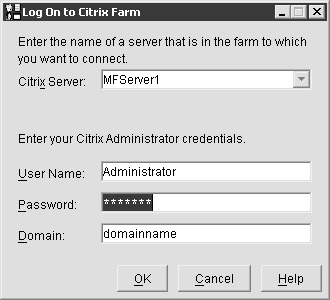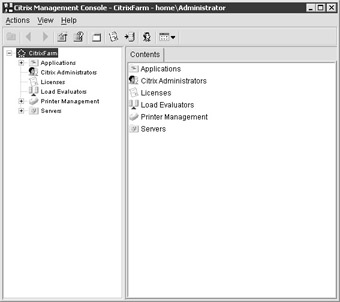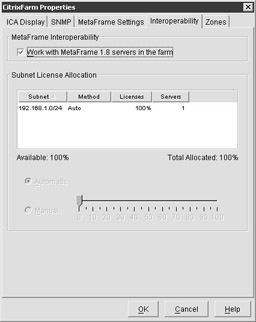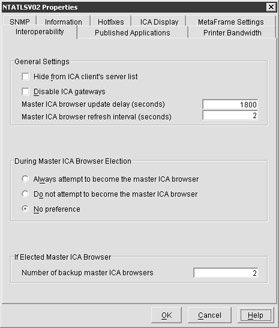Certification Objective 3.04: Migrating MetaFrame 1.8 Server Farms to XP
|
| < Free Open Study > |
|
Many users of Citrix MetaFrame XP currently maintain Citrix farms based upon older versions. The need to provide backwards compatibility is a key component of any upgrade strategy. Citrix provides the capability for Citrix MetaFrame XP to operate in a 'mixed' environment consisting of MetaFrame 1.8 servers and MetaFrame XP servers. Although there is little configuration required by an administrator to activate these functions, the underlying architecture can be far more complex.
Citrix provides two modes of operation related to interoperability. First, native mode provides support for farms consisting of only MetaFrame XP servers. This method of operation does not support older servers in the farm and is the recommended mode, unless 1.8 servers exist within the server farm. By operating in native mode, MetaFrame XP takes full advantage of many of the new features while operating without much of the overhead existing in MetaFrame 1.8 implementations.
The second mode of operation, or mixed mode, provides the backwards compatibility that MetaFrame 1.8 requires to operate in a MetaFrame XP environment. Although the MetaFrame XP server still functions under the new IMA architecture, it also enables the older ICA Browser and Program Neighborhood services to support communications with MetaFrame 1.8. Each mode is discussed to provide more detail on how each option is used in MetaFrame XP.
| Exam Watch | Mixed mode operation is only recommended for migrating Citrix MetaFrame 1.8 servers to MetaFrame XP. It was not designed to operate as a permanent solution. |
XP Native Mode
As mentioned earlier, MetaFrame XP supports two modes of operation. Native mode provides compatibility within a server farm consisting of Citrix MetaFrame XP 1.0 servers only. A farm containing only MetaFrame XP servers takes full advantage of the new feature set provided in the product, along with several network enhancements. Since the Citrix MetaFrame XP architecture and features are discussed in depth throughout this book, a limited discussion of how these apply to interoperability is provided here.
Advantages for using native mode include:
-
ICA Browser service is disabled on all servers within the farm limiting the broadcast traffic required on your network. IMA traffic used in its place is not based on broadcast traffic.
-
Program Neighborhood services are disabled on all servers within the farm.
-
Data collectors are used instead of the ICA browser service. This is a more stable solution.
-
Data is not shared with Citrix MetaFrame 1.8 servers located within the same farm.
XP Mixed Mode
To properly support backwards compatibility in a MetaFrame 1.8 server farm environment, mixed mode operation can be enabled. Though recommended only as a migration or temporary option, it does offer additional services and capabilities to administrators. With these features, however, come several stipulations that must be accounted for. Within this section, the features and caveats will be discussed to properly prepare you for using this capability.
Features provided by mixed mode operation include:
-
ICA Browser compatibility with MetaFrame 1.8 is enabled on every MetaFrame XP server in the farm.
-
Program Neighborhood compatibility with MetaFrame 1.8 is enabled on every MetaFrame XP server in the farm.
-
MetaFrame 1.8 and MetaFrame XP servers with the same farm name are displayed as a single farm to clients.
-
MetaFrame XP servers can respond to legacy UDP client requests.
-
Published applications can be load-balanced across MetaFrame XP and MetaFrame 1.8 servers with the same farm name.
-
License pooling is available between MetaFrame XP and MetaFrame 1.8 servers on the same subnet.
-
The MetaFrame XP Citrix Management Console provides intelligence for interoperability with MetaFrame 1.8.
-
MetaFrame XP servers will win ICA browser elections, providing more stable data storage.
Interoperability Considerations
Due to the nature of the operation of interoperability mode, several factors must be taken into consideration when using it. Each of these items can impose a significant affect on the use of Citrix services if not carefully accounted for. Each item is discussed and recommendations for usage are provided.
Citrix Farm Name
To properly support both Citrix MetaFrame 1.8 and MetaFrame XP in the same farm, the name of the server farm must be identical across both server platforms. When installing MetaFrame XP into an existing MetaFrame 1.8 server farm, you must create a new farm during the installation of the first server with an identical farm name. This allows the data store to be created with the appropriate information, and communication between the two farms will automatically take place. Although they are two separate farms, to the users, applications, and management utilities, they are operating as a single entity.
Application Migration
Based upon the nature of Citrix MetaFrame providing access to applications, migration of these applications cleanly is critical to the success of any implementation. Within interoperability mode, MetaFrame XP provides the ability to operate in cooperation with MetaFrame 1.8 to continue providing application services to users. In addition, there are methods for migrating published applications and their associated settings into a MetaFrame XP farm.
It is recommended not to publish applications while operating in a mixed mode environment. Although this capability exists, it must be performed correctly to accomplish this task. Additionally, when published applications are migrated to MetaFrame XP, a log is maintained in the Winnt\System32 directory. This log can assist in troubleshooting issues that may arise.
There are several rules that must be followed when dealing with published applications in this type of environment:
-
Applications installed prior to MetaFrame XP being added to the farm will upgrade successfully.
-
The back up of published application settings is recommended to help resolve any issues that may arise.
-
Newly published applications must first be published via Published Application Manager from the MetaFrame XP server. Once completed, it must then be published via the Citrix Management Console. This order must be observed for application publishing to succeed.
-
Applications viewed via the MetaFrame 1.8 version of Published Applications Manager can disappear under certain circumstances. Using the MetaFrame XP version of this utility resolves this issue.
-
Do not use Published Application Manager to remove MetaFrame XP servers from the list providing this application.
-
Application modified by the MetaFrame XP version of Published Applications Manager cannot be later modified by the version provided with MetaFrame 1.8.
License Pooling
One of the most important features of using mixed mode operation is the capability to share licenses between MetaFrame 1.8 and MetaFrame XP servers. MetaFrame 1.8 servers with connection licenses installed can share these with all servers located within the mixed mode server farm. In addition, MetaFrame XP servers can pool connection licenses it maintains to any MetaFrame 1.8 server within the farm located on the same subnet. Although this can really help in migrating to MetaFrame XP, there are several caveats that must be accounted for.
First, MetaFrame XP servers automatically win ICA browser elections. When acting as the master browser, MetaFrame XP converts ICA license gateways to ICA gateways. In addition, if ICA gateways exist prior to the installation of MetaFrame XP into the server farm, licensing updates can take up to 48 hours due to backup ICA browsers. This can affect how licensing operates within your farm. Also, MetaFrame XP servers handle connection licenses differently in mixed mode as compared to native mode. By default, connection licenses are available to all servers within a farm, in all subnets in native mode. Within mixed mode, these licenses are statically assigned to servers within a particular subnet for a farm. To manually assign licenses to specific servers, administrative intervention is required to ensure they are delineated to the appropriate devices.
Load Balancing
A new feature available with Citrix MetaFrame includes advanced load-balancing criteria from which to choose. Unfortunately, this capability is not available in a mixed mode server farm. When load-balancing applications across a mixture of MetaFrame versions, only the basic load-balancing parameters in MetaFrame 1.8 are available. In addition, a few rules are necessary for this to function properly.
These rules include:
-
A MetaFrame XP server must be the master ICA browser.
-
Only the default load balance should be configured for all MetaFrame servers.
-
Application publishing rules, as described earlier, must be considered since they also apply to load-balancing support.
-
The Qserver utility must be used to determine load values across a mixed mode farm.
Load evaluation occurs differently in a mixed mode farm. Although unusual compared to native environments, it is required to support client requests. The evaluation process includes the following:
-
ICA client connects to the master ICA browser to determine application availability.
-
MetaFrame XP servers are queried to determine lightest load based upon user connections.
-
MetaFrame 1.8 servers are queried to determine lightest load based upon user connections.
-
The master browser then chooses between the MetaFrame XP server and the MetaFrame 1.8 server with the least number of connected users. If both servers contain equal values, the MetaFrame XP server will then be chosen.
ICA Browser Elections
Once MetaFrame XP is operating in mixed mode, the ICA browser service is enabled on all servers in the farm. The master browsers generally maintain and provide information to clients on license usage and application availability. This was a service required in earlier releases of Citrix MetaFrame. MetaFrame XP servers can now participate in 'browser elections' with MetaFrame 1.8 servers on the same subnet. Used to determine the server maintaining the master information base about the server farm, it is a critical component when operating MetaFrame 1.8 server farms.
Master browser elections are based upon specific criteria. When one of these items occurs, a master browser election is forced to determine who should maintain this role. If any of the following take place, it will trigger a browser election:
-
Citrix MetaFrame server is started
-
Current master browser does not respond to a request
-
Two master browsers are detected on the same subnet
Once a browser election is triggered, the server is chosen based upon several items. Listed is the hierarchy of the election process in order starting with the first rule:
-
ICA Browser version (higher takes precedence)
-
Configured as master browser (w/ Server admin tool or registry)
-
Citrix server is Windows 2000 domain controller
-
Length of time ICA browser has been running
-
Computer name
| Exam Watch | Citrix MetaFrame XP servers always win master browser elections over MetaFrame 1.8 due to the first rule. The version number of MetaFrame XP is 2.0, which is greater than MetaFrame 1.8. |
ICA Gateways
Based upon the network architecture of previous versions of MetaFrame, broadcast traffic was used to communicate between servers and server farms. To allow servers to communicate across networks, ICA gateways were required. ICA gateways provided virtual links between servers and farms to tunnel all traffic in order to allow MetaFrame to scale outside a single network. Although MetaFrame XP does not require ICA gateways to perform this function, they are still used for backwards compatibility with MetaFrame 1.8.
ICA gateways are currently supported in mixed mode operation to allow master ICA browsers to communicate across subnets. To identify ICA gateways on MetaFrame XP servers, the Qserver utility must be used. These must be taken into consideration as plans for the upgrade of existing MetaFrame 1.8 servers using ICA gateways are migrated to MetaFrame XP.
License Migration
As part of migrating from an older release of MetaFrame to MetaFrame XP, licensing issues must be taken into account. Citrix provides a service known as Subscription Advantage, where clients meeting defined criteria receive free upgrade licenses to MetaFrame XP. Additional information related to these licenses can be found at the Citrix Web site.
There is one important technical note worth mentioning when migrating a license. When upgrading from MetaFrame 1.8, an existing base license and connection license must be installed. When adding a MetaFrame XP upgrade license, it will not function properly without finding these original licenses in place.
Citrix Farm and Server Management
To assist with interoperability issues, MetaFrame XP provides updated versions of the Citrix administration utilities used to manage MetaFrame 1.8 servers. It is recommended that you use the updated version of these utilities as they address many of the issues related to interoperability not fixed in the earlier releases. In addition, specific rules apply to using these utilities so as not to inject problems into this environment.
As mentioned earlier, it is recommended you use the MetaFrame XP version of Published Application Manager to handle applications across a mixed mode farm. In addition, the Citrix Administration utility can be used to manage some settings across both MetaFrame 1.8 and MetaFrame XP servers simultaneously. The use of the MetaFrame XP Citrix Management Console, or CMC, is generally the preferred administration tool.
Exercise 3-3: Configuring an Existing Citrix MetaFrame XP Farm to Operate in Mixed Mode
This exercise will allow an administrator to configure a Citrix MetaFrame XP server farm to operate in compatibility mode, or 'mixed mode,' and permit interoperability with previous versions of MetaFrame. It assumes that the Citrix farm was not installed, or is not currently operating in 'mixed mode.'
-
Open the Citrix Management Console by selecting Start | Programs | Citrix | Citrix Management Console.
-
Enter the information required to log on to the Citrix farm including farm name, server name, User ID, and password. (See Figure 3-25.)

Figure 3-25: Citrix Management Console logon -
Select the farm object at the top of the tree. Right-click the object and select Properties (Figure 3-26).

Figure 3-26: Citrix Management Console -
Select the Interoperability tab on the Properties dialog box. Check the box labeled Work With MetaFrame 1.8 Server In The Farm to enable mixed mode operation. Select OK on the prompt shown in Figure 3-27.

Figure 3-27: Accepting the activation of interoperability mode -
Once completed, the MetaFrame XP servers in the farm will now be able to communicate with MetaFrame 1.8 servers. Subnet license allocation options will also now be available for configuration.(See Figure 3-28.)

Figure 3-28: Configuring MetaFrame interoperability options -
After interoperability mode has been activated, an additional tab is now available on the Properties dialog box of each server object located in the Citrix Management Console. As shown in Figure 3-29, these options allow an administrator to customize several of the options discussed throughout this chapter related to mixed mode operation.

Figure 3-29: Server options available for configuring interoperability with MetaFrame I.8
Network Traffic Increases
Because of the new architecture in MetaFrame provided by IMA services, network traffic is handled differently as compared to older versions. In older versions of MetaFrame, traffic was primarily broadcast-based causing network performance and security issues. Now, MetaFrame XP provides a much more scalable, stable, and secure network infrastructure to support communications from client-to-server and server-to-server.
In order to support backwards compatibility, mixed mode operation requires that MetaFrame XP not only maintain its own internal network infrastructure, but emulate the MetaFrame 1.8 networking components as well. If not planned for properly, there could be a potentially large network impact.
Server-to-server Communication
Within MetaFrame XP, server-to-server communication is accomplished by utilizing Transmission Control Protocol, or TCP port 2512. Each server uses a direct channel to other servers as required via this single port. As compared to MetaFrame 1.8 using User Datagram Protocol, or UDP port 1604, this new architecture provides a much more reliable and scalable solution.
Once interoperability mode is activated, Citrix MetaFrame XP must now support both methods of communication. Therefore, MetaFrame XP servers will continue to use TCP port 2512 to communicate with each other, but will use UDP port 1604 to work with MetaFrame 1.8 servers. Traffic thereby increases a great deal as the number of servers located within the Citrix farms increases. Although this functionality works, it is something that, again, must be planned carefully to minimize any network impact.
Client-to-server Communication
As discussed earlier in this chapter, MetaFrame 1.8 networking is primarily broadcast-based. Client communications requirements related to interoperability mode are similar to server requirements, as clients also use UDP port 1604 to locate Citrix services. In addition, because MetaFrame 1.8 relies on the master browser to provide these services to clients, additional network overhead can quickly increase. As with server-to-server communication, care must be taken to provide services to clients without impacting the existing environment.
Now that you are familiar with issues related to interoperability, here are several scenario questions and their solutions.
| What port do MetaFrame XP servers use to communicate with each other? | TCP port 2512 |
| What is the first item that determines the master browser during an election? | ICA browser version |
| What port do MetaFrame 1.8 servers use to communicate with each other? | UDP port 1604 |
| What Citrix utility is used to determine load-balancing values in a mixed mode farm? | Qserver |
One of the most confusing issues when dealing with MetaFrame XP is interoperability mode and how it should be utilized. Due to its complex nature and interaction problems with MetaFrame 1.8, it is really only recommended as a temporary solution. In most cases, I do not suggest using it.
As you probably noticed throughout this section, there are a lot of caveats to using mixed mode, and this lists only the most common issues. Older versions of MetaFrame had concerns associated with many of the items that had been removed in XP, such as the ICA browser server and Program Neighborhood. By turning on interoperability mode, you enable these services on all XP servers to communicate with MetaFrame 1.8 servers. Many of the utilities don't work properly, or you have to use advanced command-line functions to find out valid information.
Due to the complexity involved in using this feature, try to avoid it if possible. Nevertheless, you should be familiar with the subject for the test.
-Ralph (JJ) Crump - CCNP\DP, CCEA, MCSE, MCNE
|
| < Free Open Study > |
|
EAN: 2147483647
Pages: 169